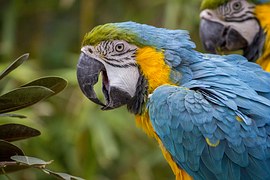Paws-itive Press
Birds as Pets
By Barbara Masi
This is a subject I am only very slightly familiar with as my mother had Canaries when I was young. I remember one with the name of Mario Lanza (that should date me) and we did love it when he sang (only the males sing.) Luckily enough, I have friends who have birds and they have assisted me with this column.
When choosing a pet bird you don’t want to get one that is too large, too loud, too expensive — and ultimately, too much to handle. In any case, whatever type of bird you are looking for, deal with a reputable breeder as they can assist you in getting the bird right for you and your family.
Birds are popular pets – they are generally easy to care for and colorful little companions. Basically there are two types – hookbills and softbills. Hookbills are all the Parrot type birds, and smaller ones like Parakeets, Lovebirds, and Cockatiels. Softbills are Canaries and Finches.
Parakeets are one of the most popular and most common first birds. Since they are fairly inexpensive and in good supply, they often are considered a “throw away bird” and are not valued as much as other feathered friends. This is a deplorable attitude with ANY pet and should be discouraged.
Parakeets small size and trainability make them a good choice for older children. Their diet, like most Parrots, consists of pellets or seeds supplemented with fresh vegetables and fruits. Pellets make far less waste than seeds, and are easier to feed once the bird is acclimated. Fresh fruits and vegetables must be washed well as birds are very sensitive to chemicals and pesticides. Cuttlebones are a way to provide calcium and the birds enjoy chewing on them.
 Most hookbills like to chew on things, and so need a variety of toys to keep them active and provide mental stimulation. The larger the bird the larger the toy, and large Macaws can go through a few toys in a day. Soft wood, hard wood like manzanita, rawhide, and cotton rope are some of the materials used to make toys.
Most hookbills like to chew on things, and so need a variety of toys to keep them active and provide mental stimulation. The larger the bird the larger the toy, and large Macaws can go through a few toys in a day. Soft wood, hard wood like manzanita, rawhide, and cotton rope are some of the materials used to make toys.
Some Canaries are amazing singers. They are solitary unless breeding, so they don’t like to share with other canaries. Putting a male and female together will cause a male to stop singing, and two males may fight, so they are kept singly.
The canary is perfect for beginners who aren’t sure they want as much interaction as some other species require. They would d rather not be handled and are happy just entertaining you with their song. It is a good pet for children as they allow youngsters to see a bird close up but not have to interact with it.
Finches are flashy birds that are fast moving and fun to watch. They are constantly twittering but it is at a level below the decibel level of Parrots. When purchasing Finches, remember that they do better in a social situation, so plan on buying two or more and giving them a cage with plenty of space to exercise their wings. These birds move by flying and they don’t climb for exercise. Also remember that when they’re too crowded, territorial cage battles between cage mates will erupt.
Parrots can be noisy. Keep this in mind when choosing a breed of bird and think about neighbors especially if you live in an apartment or condo. Conures are remarkably loud for their size, and a Macaw can easily be heard down the block when in full yelling mode. Cockatiels and the smaller parrots will make some noise, but rarely get too loud unless excited.
The smaller Parrots are not as good at mimicking sounds and speaking as the larger Parrots, and it varies greatly by each individual bird. My friend had a Jardine’s Parrot that kept making the strangest noise – it took the longest time for her to realize it was a squeaking cabinet door. He also had the beep of the microwave down pat and mimicked her telling the dogs to be quiet.
Cages should be the largest possible. Softbills like Canaries and Finches aren’t interactive the way that Parrots are, and so need flying space to stay healthy. The larger the cage the better it is for the birds, especially if multiples are kept such as a group of Zebra Finches. Wire spacing will depend on the size of the bird, with smaller birds needing no more than 1/2″ spacing and larger Parrots closer to an inch. Birds can be messy with their food, so an easy to clean location is a good idea. The cage also needs to be in a draft-free location, which is warm but not overheated.
Here’s an interesting caution that was shared with me – be aware that smaller birds (Canaries, Finches and small Parrots) can be sickened and die from the fumes created by non-stick cooking pans used on high heat. You won’t smell anything, but fumes are created and can easily kill the small birds. Locating a cage in or near the kitchen if you use non-stick cookware should be avoided.
The care for larger birds – African Greys, Macaws, etc. is largely the same – although their life expectancy is longer, and their “misbehavior” due to lack of physical, social, and mental stimulation is more intense (and possibly destructive). More on the larger birds in a future column.

